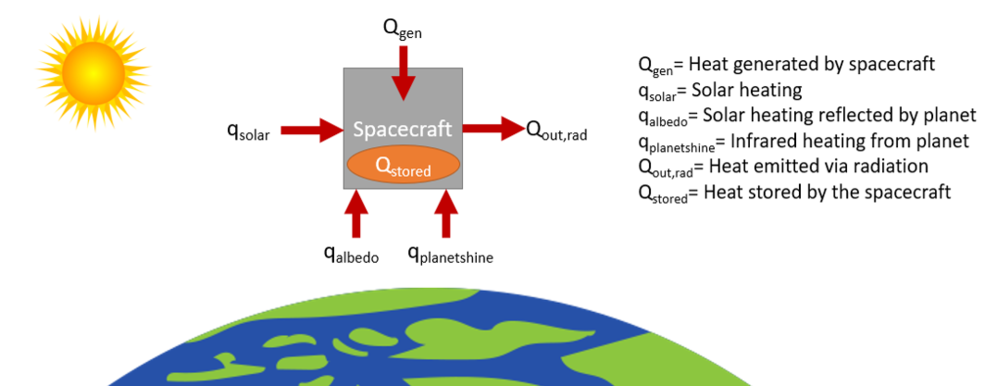Satellite hardware undertaken the physical systems required for operation, ensuring functionality and mission success.
Satellite Structure or Bus
A satellite bus, also referred to as a spacecraft bus or satellite platform, forms the core of a satellite. It carries and supports the primary systems and subsystems required for the satellite’s operation, while the payload, which varies depending on the satellite’s purpose and mission, is attached to the bus.
For instance, the Boeing 702 bus family, covering platforms from 1500-6100 kg and power outputs of 3–18 kW, with over 50 launches since the late 1990s.
Power System
It covers all aspects of power generation, storage, condition, distribution, and conversion for all types of space applications. Missions can last between a few minutes to decades (ISS) and request from a few watts (CubeSats) to tens of kilowatts.
A launcher will live out of electrochemical sources (batteries, fuel cells, and supercapacitors), while a satellite in Earth orbit will rely on a solar generator. They are working together to ensure an uninterrupted power supply for all components. It is the heaviest equipment of any spacecraft.
Propulsion System
Instead of large delta-v maneuvers for interplanetary transfer, satellites typically carry only small thruster systems sized for orbit insertion, station-keeping, attitude control, and end-of-life de-orbiting.
These micro-propulsion systems-ranging from cold-gas jets to electric ion or Hall-effect thrusters-provide low thrust but high efficiency.
Thermal Control System
The role of the thermal control system is to keep the temperature of the components within required temperature limits for given orbits, power demand, operations, etc. It also should reduce temperature gradients across the spacecraft and some components like lenses.
The basic heat sources in a spacecraft are the instruments, heaters or solar absorption while the only heat loss mechanism is radiation.

Communication System
It facilitates data exchange between the satellite and ground station using antennas, transceivers, and modulators. The communication can be one-way, such as television broadcast satellites, or two-way, such as satellites that carry internet traffic, telephony, radio communications, and navigation signals.
This block diagram2 shows a simple unidirectional communication between Earth stations and a satellite. Bidirectional satellite communication and cross-link, where two satellites communicate with each other, are similar to this process.

Attitude and Orbit Control System (AOCS)
This system allows the satellite to maintain its intended orientation and trajectory. It is in charge of the following3:
- Automatic 3-axis control of the satellite attitude
- Orbit control for which the needed thrust impulses are provided by the propulsion subsystem
- Management of the propulsion subsystem
- Automatic 1-axis control of the solar array orientation
- Orienting the solar array towards the Sun in case of electrical anomaly
- Providing ancillary attitude data to the Payload Module
Payload System
The system carries mission-specific equipment, such as cameras, sensors, or scientific instruments.
Onboard Computing and Control
This is the brain of the satellite, it is responsible for processing mission commands and coordinating all other subsystems, including the payload.
A notable mention is RAD7504, a radiation-hardened5 general-purpose processor based on the original PowerPC 750 microprocessor designed by Motorola and IBM.
Sensors and Actuators
A satellite sensor is a device that detects and responds to types of input from the physical environment. The input can be varied, from light, heat, motion, moisture, pressure to any kind of environmental phenomena. The output is generally a signal, for the computing to process.
Meanwhile, an actuator is a device that takes energy and converts it into motions. It is operated by a source of energy, typically electric current, fluid pressure, or air pressure.
Data Storage System
The “Housekeeping data” is information about the satellite with its health and safety. This mainly used by the ground crew to ensure everything is working properly.
In addition, the instruments also have their own data, “Science data” from the sensors. Most of the data that being transmitted to the ground is this.
On older satellites, data was stored on magnetic tape6 (just like in an old science fiction movie). Tape is very reliable, since it isn’t easily wiped out by cosmic rays or charged particles that stream from the sun. The main disadvantage with tape is that it requires moving parts, and moving parts in vacuum require special engineering.
Modern satellites store their data in solid state memory – a huge ‘bank’ of computer memory chips. These are very similar to ordinary computer memory, except they are usually ‘radiation hard’, meaning they are less likely to get wiped out by random cosmic radiation. Since they have no moving parts, they are more reliable than tape systems from an engineering standpoint.
Footnotes
-
https://www.nasa.gov/smallsat-institute/sst-soa/thermal-control/ ↩
-
https://se.mathworks.com/help/satcom/gs/what-is-satellite-communications.html ↩
-
https://www.esa.int/Applications/Observing_the_Earth/Meteorological_missions/MetOp/Attitude_and_orbit_control ↩
-
https://www.baesystems.com/en-media/uploadFile/20210404045936/1434555668211.pdf ↩
-
Making electronic components resistant to damage or malfunction caused by high levels of ionizing radiation ↩